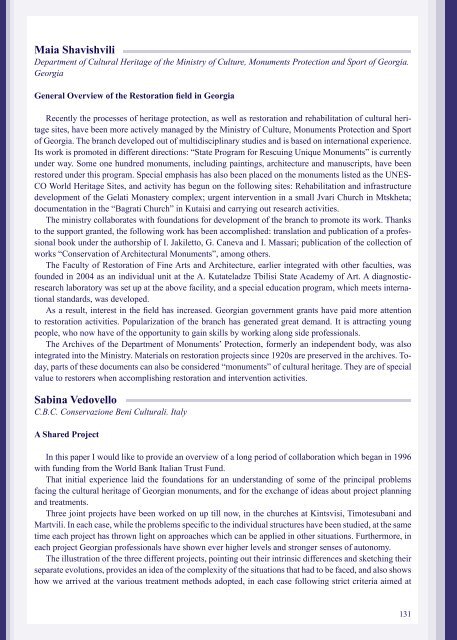Abstracts - International Initiative for Georgian Cultural Studies
Abstracts - International Initiative for Georgian Cultural Studies
Abstracts - International Initiative for Georgian Cultural Studies
You also want an ePaper? Increase the reach of your titles
YUMPU automatically turns print PDFs into web optimized ePapers that Google loves.
Maia Shavishvili<br />
Department of <strong>Cultural</strong> Heritage of the Ministry of Culture, Monuments Protection and Sport of Georgia.<br />
Georgia<br />
General Overview of the Restoration field in Georgia<br />
Recently the processes of heritage protection, as well as restoration and rehabilitation of cultural heritage<br />
sites, have been more actively managed by the Ministry of Culture, Monuments Protection and Sport<br />
of Georgia. The branch developed out of multidisciplinary studies and is based on international experience.<br />
Its work is promoted in different directions: “State Program <strong>for</strong> Rescuing Unique Monuments” is currently<br />
under way. Some one hundred monuments, including paintings, architecture and manuscripts, have been<br />
restored under this program. Special emphasis has also been placed on the monuments listed as the UNES-<br />
CO World Heritage Sites, and activity has begun on the following sites: Rehabilitation and infrastructure<br />
development of the Gelati Monastery complex; urgent intervention in a small Jvari Church in Mtskheta;<br />
documentation in the “Bagrati Church” in Kutaisi and carrying out research activities.<br />
The ministry collaborates with foundations <strong>for</strong> development of the branch to promote its work. Thanks<br />
to the support granted, the following work has been accomplished: translation and publication of a professional<br />
book under the authorship of I. Jakiletto, G. Caneva and I. Massari; publication of the collection of<br />
works “Conservation of Architectural Monuments”, among others.<br />
The Faculty of Restoration of Fine Arts and Architecture, earlier integrated with other faculties, was<br />
founded in 2004 as an individual unit at the A. Kutateladze Tbilisi State Academy of Art. A diagnosticresearch<br />
laboratory was set up at the above facility, and a special education program, which meets international<br />
standards, was developed.<br />
As a result, interest in the field has increased. <strong>Georgian</strong> government grants have paid more attention<br />
to restoration activities. Popularization of the branch has generated great demand. It is attracting young<br />
people, who now have of the opportunity to gain skills by working along side professionals.<br />
The Archives of the Department of Monuments’ Protection, <strong>for</strong>merly an independent body, was also<br />
integrated into the Ministry. Materials on restoration projects since 1920s are preserved in the archives. Today,<br />
parts of these documents can also be considered “monuments” of cultural heritage. They are of special<br />
value to restorers when accomplishing restoration and intervention activities.<br />
Sabina Vedovello<br />
C.B.C. Conservazione Beni <strong>Cultural</strong>i. Italy<br />
A Shared Project<br />
In this paper I would like to provide an overview of a long period of collaboration which began in 1996<br />
with funding from the World Bank Italian Trust Fund.<br />
That initial experience laid the foundations <strong>for</strong> an understanding of some of the principal problems<br />
facing the cultural heritage of <strong>Georgian</strong> monuments, and <strong>for</strong> the exchange of ideas about project planning<br />
and treatments.<br />
Three joint projects have been worked on up till now, in the churches at Kintsvisi, Timotesubani and<br />
Martvili. In each case, while the problems specific to the individual structures have been studied, at the same<br />
time each project has thrown light on approaches which can be applied in other situations. Furthermore, in<br />
each project <strong>Georgian</strong> professionals have shown ever higher levels and stronger senses of autonomy.<br />
The illustration of the three different projects, pointing out their intrinsic differences and sketching their<br />
separate evolutions, provides an idea of the complexity of the situations that had to be faced, and also shows<br />
how we arrived at the various treatment methods adopted, in each case following strict criteria aimed at<br />
131



